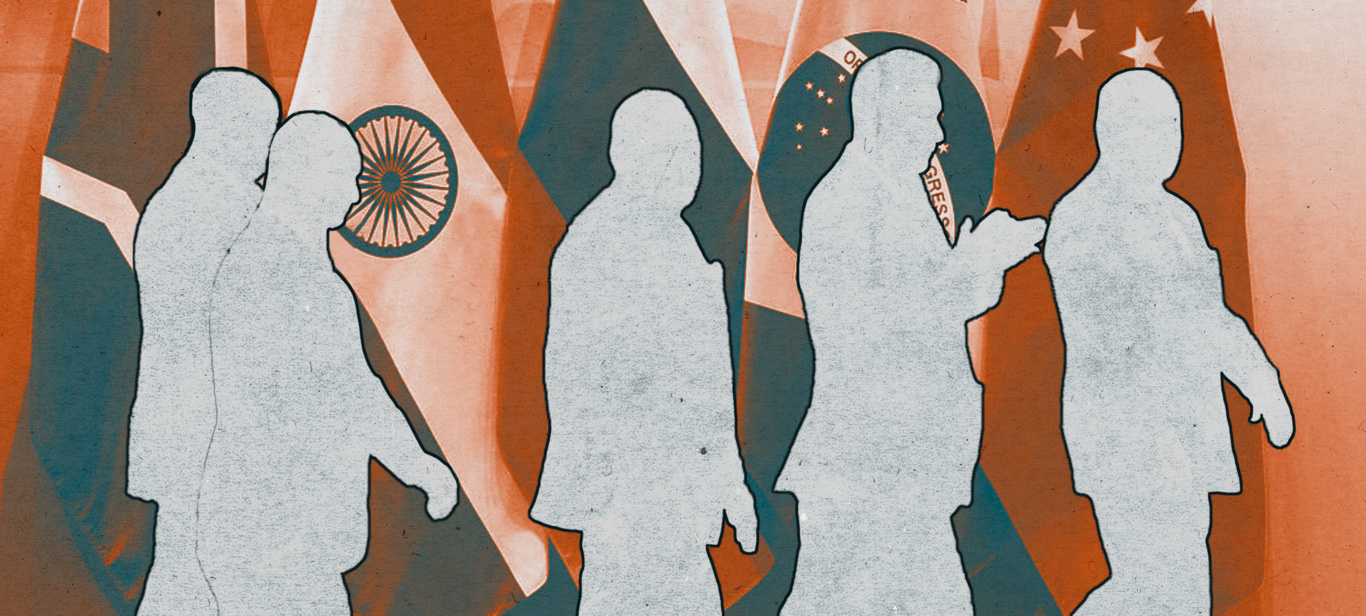The war in Nagorno-Karabakh initiated by Azerbaijan, Turkey’s involvement in Syria, the authoritarian rule in Iran, and Russia’s full-scale invasion of Ukraine — this incomplete yet indicative list of recent events underscores the escalating trend of imperialistic arbitrariness worldwide in the conditions of non-interference. As part of our “Dialogues of Peripheries” conference, one of the sessions delved into the historical evolution of authoritarian systems, drawing examples from Russia, Iran, and Hungary.
Speakers analyzed the patterns observed in these regimes, shedding light on the reasons for their emergence to their rise and exploring potential strategies for countering imperialistic violence today. This discourse holds particular significance in today’s context, as political ambitions, unrestrained power expansion, and predatory interests not only suppress citizens within specific regimes but also manifest in belligerent actions beyond the borders of authoritarian nations.
The panel discussion was skillfully moderated by Aliona Lyasheva, a sociologist and the editor of “Spilne” journal. The speakers included Ilya Budraitskis, a Russian political and cultural theorist and activist; Frieda Afari, an Iranian American socialist, feminist, translator, and writer; and Csaba Vince, a Hungarian journalist.
From guided democracy to dictatorship: The evolution of Putin's regime
Ilya Budraitskis identifies the full-scale invasion of Ukraine in February 2022 as the pivotal moment marking the irreversible transformation of Putin’s regime into an authoritarian, and possibly outright fascist, one. The Russian regime systematically approached this shift, concurrently escalating external imperialist aggression while solidifying an internal dictatorship within the Kremlin.
“Examining the history of this regime from the early 2000s, or even the 1990s, provides insight into its formation. We observe the pivotal role of the experience during the First Chechen War and subsequently the Second Chechen War, which commenced precisely when Putin assumed power in the autumn of 1999. These events were instrumental in shaping the trajectory of this political regime,” the researcher stated.
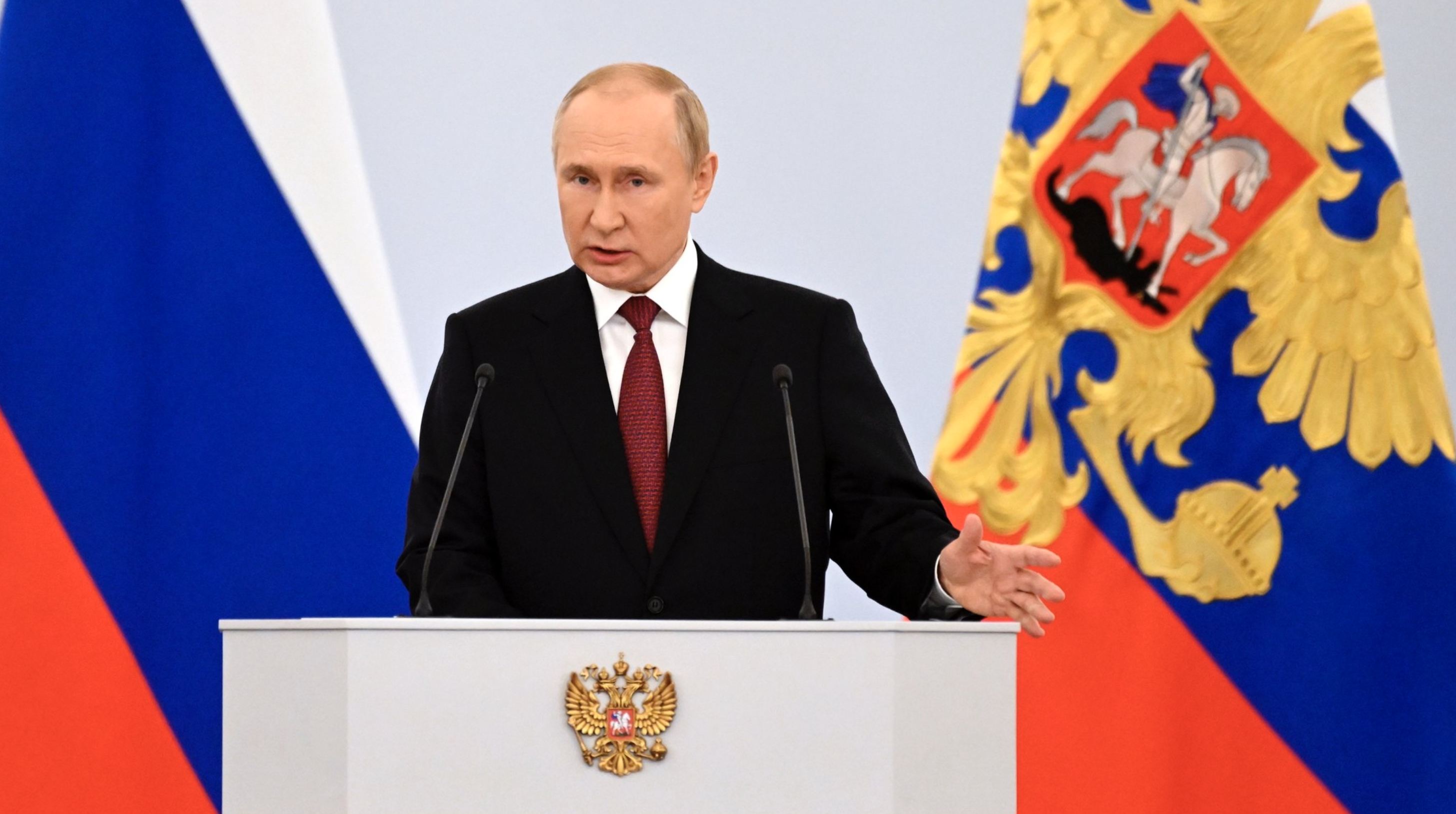
President of the Russian Federation Vladimir Putin during a speech at the “accession” ceremony of the Donetsk, Luhansk, Kherson, and Zaporizhzhia regions to the Russian Federation on September 30, 2022 in Moscow, Russia. Photo: AR
While Russia previously maintained the semblance of a controlled democracy or electoral authoritarianism with restricted spaces for expressing opinions, within a week of the beginning of the full-scale invasion, the political regime in the Russian Federation acquired the attributes of a dictatorship. The latter was rooted in unwavering support for the war, the president, and a sense of belonging to the Russian community, forming the foundation for the construction of the regime.
“Backing Putin, endorsing the war – that’s what qualifies you as a genuine member of the community, a true participant in society,” Budraitskis underscored.
As of today, there are over 600 officially recognized political prisoners in Russia. However, the actual number is likely higher, especially since February 2022 when individuals have been detained for openly expressing disagreement with such a civic identity. Any critical statements about the war have become a criminal offense, and stringent censorship has been imposed on all independent media outlets.
Furthermore, there has been an increase in the ideologization of culture and education. Many educational institutions now offer specific ideological courses. For instance, the discipline “DNA of Russia” recently emerged in universities, where biological, cultural, and historical aspects are equated, collectively termed the “common heritage” of Russians. The ideological apparatus also actively works in schools.

Parade of “children's troops” in Rostov-on-Don, May 2015. Photo: Reuters
We are witnessing the transformation of Russia into a totalitarian state. The crucial question is, how did this transformation unfold? Understanding the history of the Putin regime’s evolution highlights the significance of the link between external and internal factors. External aggression and military operations serve to unify society, fostering a sense of peace and social harmony within the country. Conversely, any internal opposition or grassroots social movements are labeled as an “external threat” or an “intervention by external enemies.”
Budraitskis emphasizes that a clear and unwavering anti-revolutionary stance essentially projected onto historical contexts, has become a pivotal component in the establishment of Russia’s authoritarian regime.
“If you pay close attention to Putin’s speeches, you’ll notice that he views the concept of revolution as a form of ‘intervention by external forces.’ This explanation was even applied to characterize the events of the Russian Revolution of 1917. He also framed the protests in Russia in 2011-2012, which were the largest anti-regime protests in the country’s history, and, of course, the events in Ukraine in 2014 in a similar manner. In a sense, we can say that the invasion of Ukraine was also a strategy to avert potential challenges from below to the regime in Russia. It was part of a very consistent and clear anti-revolutionary stance that underlies this regime,” explained the speaker.
The question arises about how to identify the regime in Russia after the beginning of the full-scale invasion, following its shift into an overtly dictatorial form. Is it appropriate to characterize it as fascism?
“Undoubtedly, this represents a form, a new manifestation of fascism, a new form of an extreme, highly repressive authoritarian state that bears little resemblance to the historical fascisms witnessed in various European countries during the 1930s. This new iteration of fascism stems from the ethos of the neoliberal transformation of society, it originates from the atomization brought about by the market, the market economy, and the relationships it introduced into society. Therefore, this new form of fascism cannot be accurately characterized in terms of mass mobilization,” explained Budraitskis.
This political formation doesn’t align with classical fascism as a mass movement; rather, it thrives on deep depoliticization, feelings of powerlessness, and prevailing fear in society. While these sentiments may occasionally bring people together, sparking sporadic unrest, they do not coalesce into an organized movement. Budraitskis suggests that this extreme form of neoliberal authoritarian capitalism in Russia is not an isolated occurrence but mirrors the acceleration of neoliberal trends globally.
Peculiarities of the imperialist regime in Iran
Frieda Afari highlighted the socio-economic foundations of Iranian authoritarianism. Iran functions as an authoritarian Islamic fundamentalist theocracy with a focus on Shia expansionism, shaping its military interventions in the region based on Shia ideology. According to the researcher, Iran exemplifies militarized state capitalism and operates as a regional imperialist power in the Middle East.
In numerous aspects, Iran perpetuated the economic trajectory of the preceding Pahlavi regime, featuring a status economy marked by the fusion of industry and the military. However, following the 1979 revolution, Ayatollah Khomeini, the founder of the Islamic Republic, utilized anti-American rhetoric to suppress any progressive opposition and garner support from segments of the Iranian and global left.
Frieda Afari notes that the Iranian regime’s anti-American discourse is intricately linked to its capitalist and Persian Shia nationalist aspirations, consequently, its anti-imperialism is deemed counter-revolutionary.
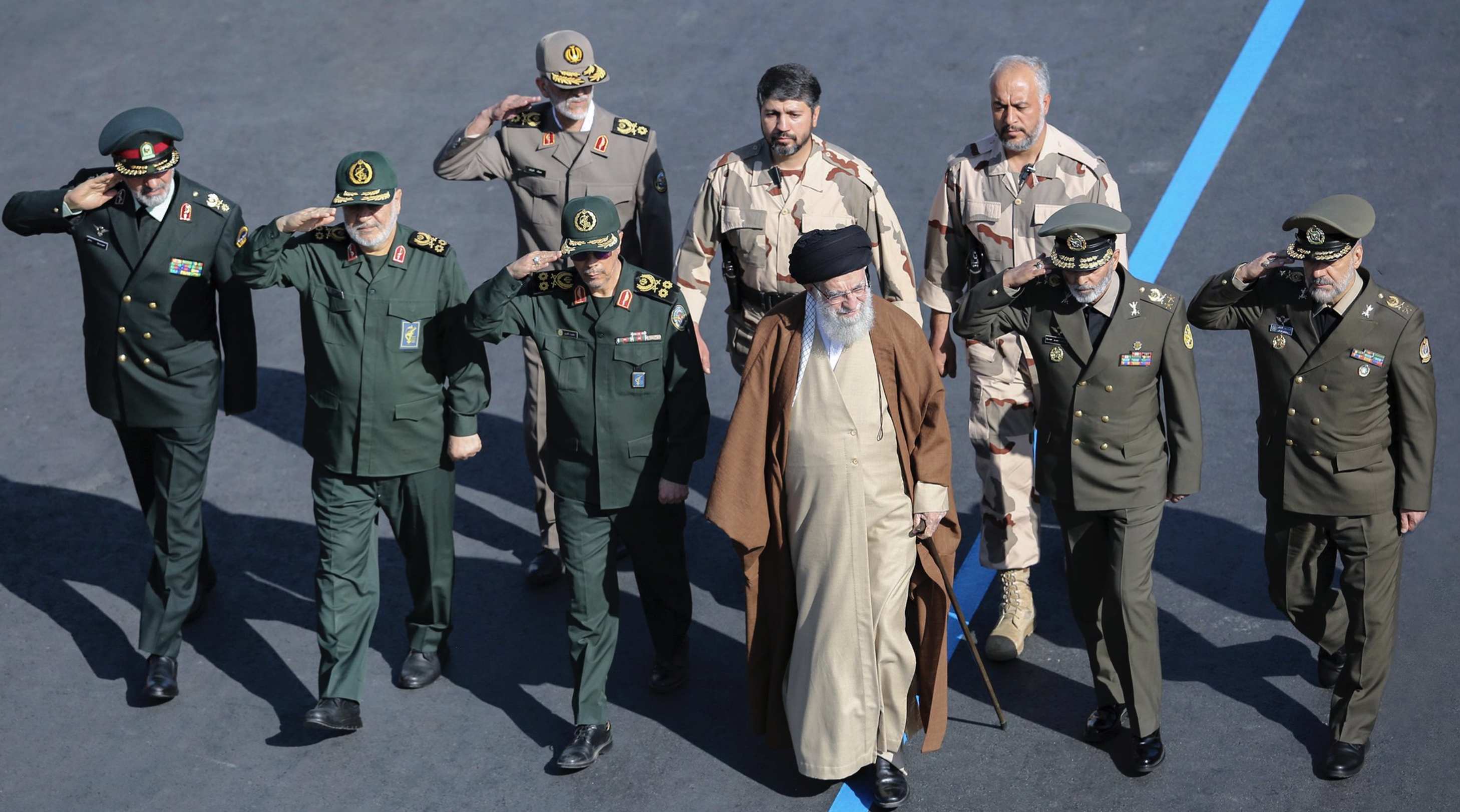
Iran’s Supreme Leader Ayatollah Ali Khamenei inspects a group of cadets accompanied by military commanders in Tehran, Iran on October 10, 2023. Photo: Office of the Supreme Leader of Iran via AP
After the Iran-Iraq war of 1980-1988, when oil revenues were substantial, the regime initially allocated a portion of its profits to develop infrastructure, healthcare, education, and benefits to a significant portion of the working class, contingent on loyalty to the dominant ideology. However, as time passed, an increasing share of oil profits started being directed towards armaments and military-political interventions in other countries in the region. Approximately 80% of Iran’s economy, predominantly comprising oil and gas, telecommunications, and automobiles, is under the control of the Islamic Revolutionary Guard Corps, serving as Iran’s de facto military and primary employer.
“The core of Iran’s Islamic Revolutionary Guard Corps is as the de facto state of Iran, suppressing the struggles of workers, youth, women, and oppressed minorities within the country. This ‘core’ also spearheads Iran’s military interventions in Syria, Iraq, and Lebanon, either directly or through supported armed groups such as Hezbollah in Afghanistan and Lebanon, which receive financial backing from the Iranian state,” Afari stressed.
In a public speech in 2018, before assuming the presidency, Hassan Rouhani clearly articulated that Iran’s strategic borders encompass the Indian subcontinent in the east, the Caucasus in the north, the Red Sea in the south, and the Mediterranean Sea in the west. Consequently, while Iran operates as an authoritarian Islamic fundamentalist theocracy with aspirations for ex-Shia expansionism, its military interventions in the region stem from a combination of theocratic adventurism and ambitious yet speculative goals for future economic gains.
By the time the Trump administration withdrew from the Iran nuclear deal in 2018 and imposed severe sanctions, Iran had become the second-largest economy in the Middle East after Turkey, positioning itself as a rival to Saudi Arabia in the struggle for regional dominance.
Currently, the Iranian regime holds hope that, with the assistance of China and Russia, it can navigate out of the existing crisis and continue its claim as a regional superpower.
“Functioning as an inefficient militarized theocratic state capitalist regime, where over 80% of capital is owned and controlled by the Islamic Revolutionary Guard Corps or its contractors, the regime has remained unaccountable; even from a capitalist standpoint, it allocates an increasing portion of its oil revenues to militaristic projects that don’t generate profits until later. Unfortunately, with the recent sale of drones and missiles to Russia for use in the genocidal war in Ukraine, the Iranian regime is profiting from these endeavors,” researcher highlighted.
Funds generated from the sale of oil, gas, and petrochemicals, not allocated to military projects, are embezzled by state leaders and their associates. Concurrently, Iranians suffer from inequality and malnutrition, with over 60% of the population residing below the poverty line. 90% of Iran’s 13 million workers operate as contract workers, experiencing limited rights and benefits.
Officially, there are 28 million working-age individuals in Iran (considering a total population of 87.9 million). Millions engage in informal labor without any corresponding rights, with women particularly prevalent in the shadow sector. The actual unemployment rate exceeds the official 60% figure. The minimum wage in Iran stands at $100 per month for a family of four, and inflation is steadily eroding its value.
The challenging economic circumstances have compelled the Iranian government to explore new avenues for economic recovery through partnerships with China and Russia. China’s “One Belt, One Road” initiative emerges as a potential solution to navigate around sanctions imposed on Iran. Within the framework of this project, a significant agreement was inked in the fall of 2019, outlining a $400 billion investment in Iran for the development of oil, gas, and other infrastructure. A clause in the agreement entails the deployment of 5,000 units of Chinese security forces as bodyguards, exchanged for Iranian oil, gas, and petrochemicals at a discounted rate of 30%. It entails a permanent presence of Chinese soldiers on Iranian soil. Both parties have committed to this agreement for a 25-year period, with Chinese investment slated to increase every five years.
For decades, the regime has leveraged Iranian nationalism to garner support for its military interventions and programs, speculating on notions of dignity and strength. That explains why the majority of Iranians were satisfied with military interventions and nuclear missile programs until 2017 when protests ensued. However, as the economic situation deteriorated, protests were suppressed, pandemics started, and the “Woman, Life, Freedom” movement gained momentum in 2022, most Iranians began to realize that they were robbed in order to fund military programs. Consequently, empathy for the affected peoples of the region and Ukrainians, victimized by Iran’s interference in politics and wars, started to gain traction.
Furthermore, the modern Iranian state maintains strained relations with provinces housing national minorities – Kurds, Arabs, as well as Baluchis and Turkmens, face substantial discrimination and oppression, depriving them of basic resources.
“Iran's national minorities are forbidden from using their mother tongue as a language of education, and a majority of them suffer from poverty and state repression,” the researcher explained.
The regime exhibits notable apprehension towards movements advocating for self-determination in Iran, particularly in Kurdistan. The “Woman, Life, Freedom” movement, sparked in September 2022 following the killing of a young Kurdish woman, Magha Amini, by the police, triggered significant protests in Kurdistan and beyond. Additionally, the regime is uneasy about demonstrations in Khuzestan, where people protest against ethnic repression and the oppression of Khuzestan as an ethnic minority, as well as protests linked to environmental issues. Authorities frequently express concerns about the situation in Iran’s economically deprived province, Balochistan, where substantial anti-government protests are frequent.
“Baluchi women are making powerful feminist statements and challenging the Baloch leadership, accusing it of misogyny and making deals with the Iranian regime and the Taliban,” Afari highlighted. She underscored that the Iranian movement “Woman, Life, Freedom” has conveyed to the world the significance of advocating for women’s rights within the context of authoritarian regimes.
The Hybrid Regime: The evolution of Orbán’s rule
Journalist Csaba Vince pointed out that characterizing Hungary’s political system as authoritarian is challenging, as the regime in this country significantly differs from those in Russia or Iran. Presently, terms like “flawed democracy” or “hybrid regime” are commonly used.
Viktor Orbán and his Fidesz party have held power since their victory in the 1998 elections. In the late 1980s, his movement, which later transformed into a political party, adopted a more radically liberal approach to politics than any other in Hungary — they advocated for the rule of law, parliamentary democracy, the fight against corruption, and cultural diversity. Today, this may sound ironic.
Since 2010, Orbán has changed the game completely: he introduced an entirely new constitution, overhauled the judicial and electoral systems, and transformed state media into propaganda outlets. Despite these changes, Orbán himself characterizes his system as a liberal democracy. Main “enemies,” frequently targeted by the ruling regime, include migrants, Brussels bureaucrats, and George Soros. Notably, during his political science studies in Budapest and Oxford, Orbán’s education was financially supported by George Soros, who now stands as his primary international opponent and heads the Open Society Foundation.
Fidesz and Hungary currently operate within a corporate-friendly capitalist system that has progressively favored domestic companies. While this might appear positive, Hungary contends with an alarmingly high level of corruption. A noteworthy example is Lorink Mešáros, a former gas fitter and Viktor Orbán’s close confidant, who swiftly ascended to become Hungary’s primary oligarch and the wealthiest individual in the country. Mešáros acquired banks, establishing a vast corporation that oversees various sectors, including media, soccer teams (even beyond the country’s borders), energy, and IT.
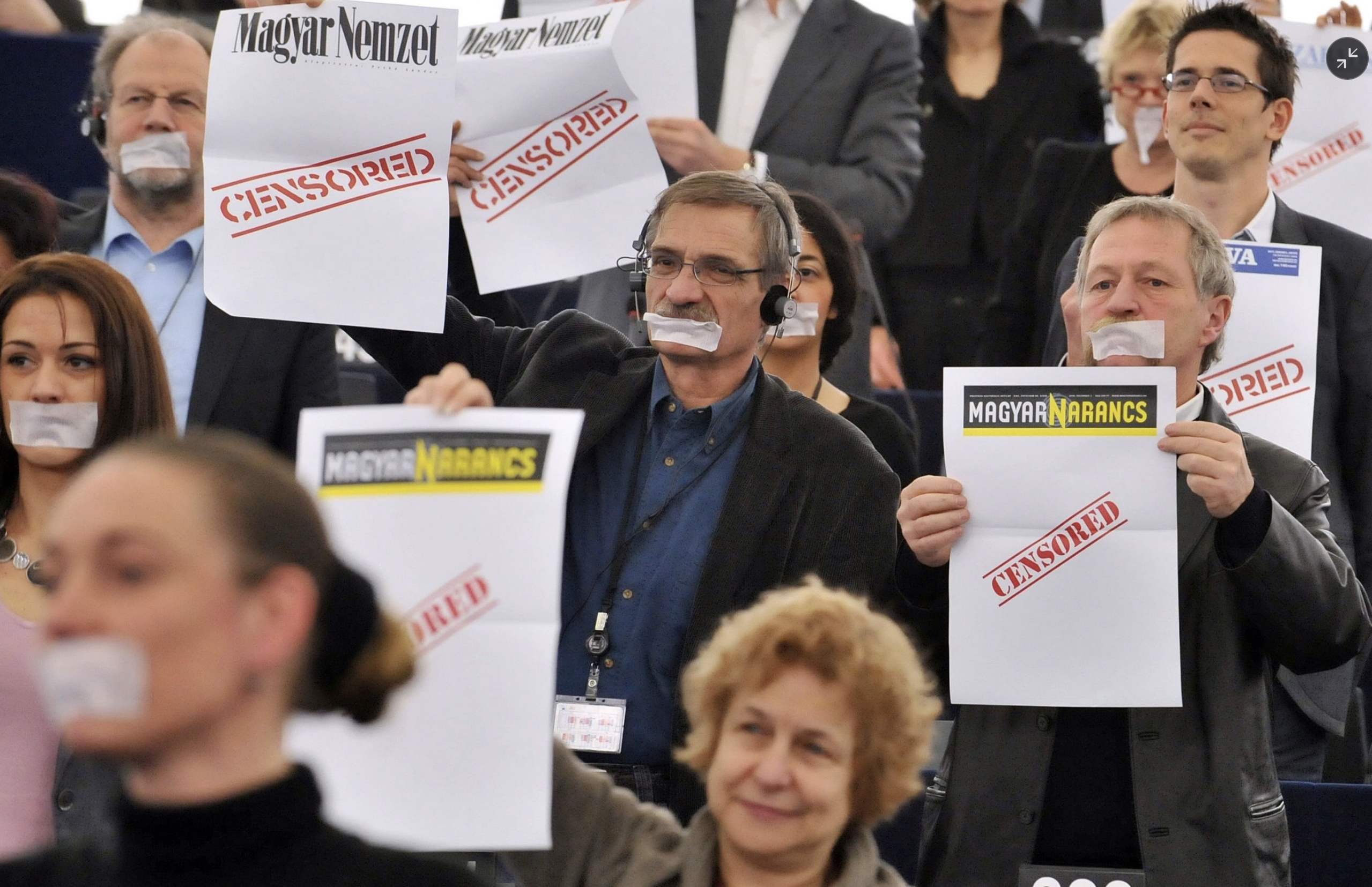
Members of the European Parliament protest against the suppression of press freedom in Hungary during a speech by Viktor Orbán – Hungary’s six-month presidency of the European Union on that day, Strasbourg, January 19, 2011. Photo: Georges Gobet / AFP / Scanpix / LETA
Hungary has close economic connection with Germany at the international level. Certain leaders of German corporations have even openly claimed that they could contact the Hungarian foreign minister at any time, and he would heed their requests.
For instance, a few years ago, BMW requested the Hungarian government to nearly double the maximum allowable overtime hours. Other German corporations, including Mercedes-Benz and Volkswagen, also reap substantial profits in Hungary due to inexpensive and skilled labor. The concerning aspect is that the bulk of these profits is pulled out from the country without encountering any substantial barriers.
Over the past few years, Hungary has navigated challenging geopolitical conditions, which can be contextualized within the backdrop of various wars. In 1999, during Orbán's first government, Hungary joined NATO at a time when the alliance actively conducted airstrikes in Yugoslavia. In 2001, Hungary deployed troops to Afghanistan for a 20-year commitment, significantly impacting the country’s economy. Throughout the 2000s, Orbán maintained an anti-Russian stance. In 2008, when Russia attacked Georgia, the Hungarian president called for the immediate NATO inclusion of Georgia and Ukraine due to the threat from Russia. In 2014, Orbán called the invasion of Crimea aggression and once again urged the EU to deliver a decisive response. What notable shift occurred after 2014? What led Hungary to essentially make a 180-degree turn?
To comprehend Hungary’s foreign policy, it’s crucial to acknowledge that Orbán emulates Germany in almost every aspect, following it in the footsteps. He viewed economic sanctions against Russia as a joke, and he perceived the EU’s approach to resolving the crisis in Ukraine as lacking seriousness. When the Minsk-2 deal came into effect, Orbán became convinced that sanctions alone would not deter Russia. There is a theory suggesting that he sought closer ties with Putin to prevent potential Russian aggression against Hungary and to restore influence in the region.
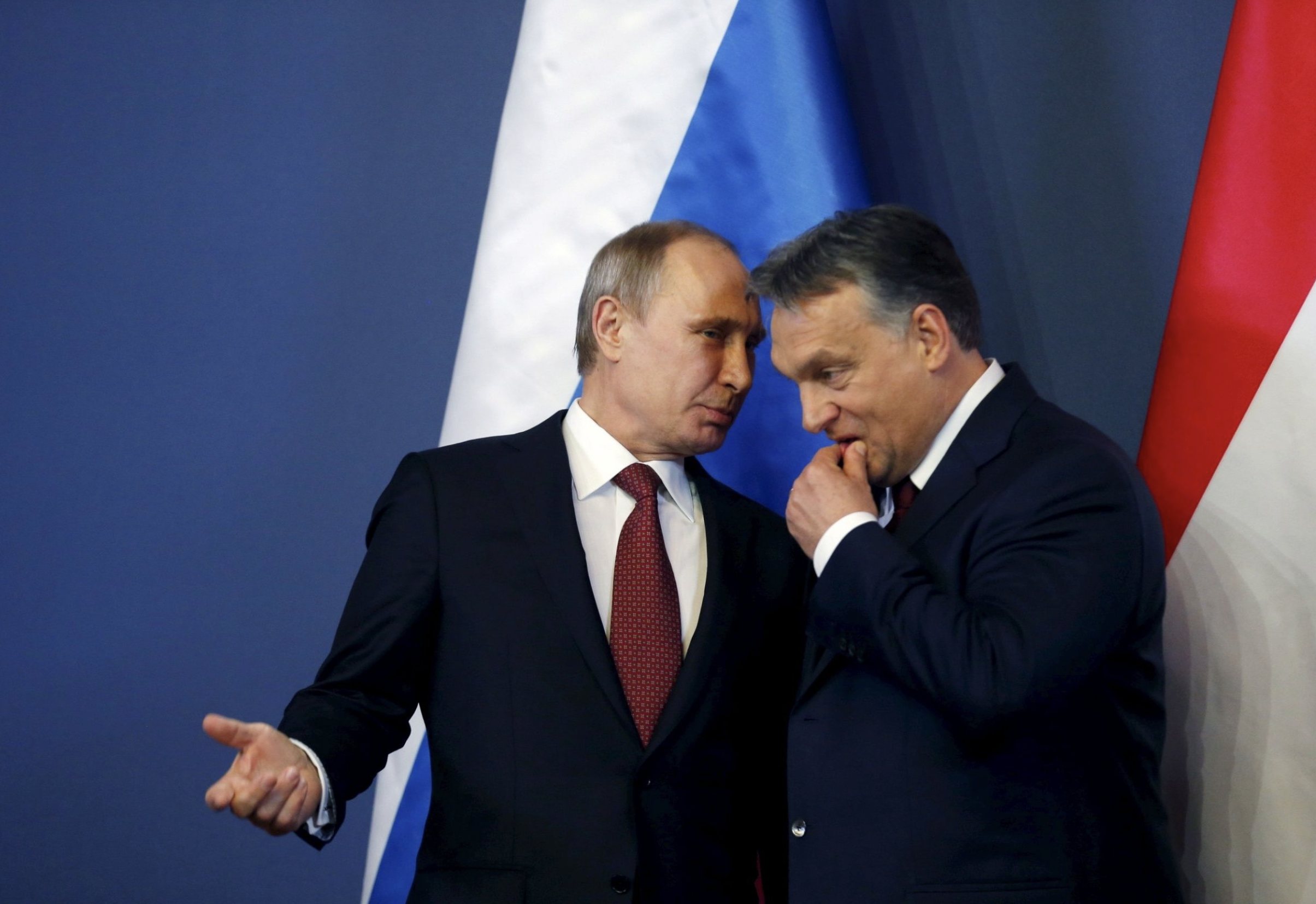
Vladimir Putin talks with Viktor Orbán before a joint press conference in Budapest, April 17, 2015. Photo: Laszlo Balogh / Reuters
The EU voiced concerns about Hungary drifting away from European values and exhibiting increasing authoritarian tendencies. Orbán responded by advocating for Hungary’s greater independence and broadening its economic and political connections to the East. The harsh criticism from the West only served to bring Hungary closer to Russia and China.
“This is noteworthy considering he built his political career, as I already explained, on anti-Russian and anti-communist sentiments. It highlights Orbán's remarkable flexibility, both domestically and internationally,” explained Vince.
Orbán capitalized on the 2015 refugee crisis, positioning himself as the “savior” of Christian Europe, a move that strained relations with the EU. During this period, he drew even closer to Putin and began expressing concerns about the situation of Hungarian minorities in Ukraine, particularly the language law, which mandated the use of the Ukrainian language in all spheres except for personal or religious ones. A year after Russia’s invasion of Crimea and the beginning of the war against Ukraine, German, Dutch, and Austrian companies entered into an agreement with Russia and Gazprom to construct the Nord Stream 2 gas pipeline, facilitating the quick and cost-effective delivery of gas from Russia to Europe.
Vince highlighted that opposing the regime in Hungary is almost impossible, attributing it to a fragmented opposition and the authorities’ control over all public mass media. Despite opposition figures entering parliament, they struggle to gain influence, as Fidesz consistently secures victories by a significant margin.
What can the left do in such a situation? A key strategy to be amplified is to primarily focus on the development of grassroots movements built on dialogue and education for workers and students. And criticize Orbán as a corrupt figure and an ally of dictators.
“All grassroots movements should center on this to alter the political landscape in Hungary,” concluded Vince.
***
Authoritarianism is not confined to the contemporary Russian regime but serves as the vanguard for right-wing movements globally. While authoritarian tendencies may not always lead to wars, they consistently normalize aggressive attitudes by suppressing dissent and inconvenience. Targets can vary, including women, queers, migrants, as seen in Iran or Hungary, or residents of neighboring countries, as in the case of Russia. However, even authoritarian regimes have vulnerabilities—economic bankruptcy, environmental catastrophes, opposition from oppressed national and ethnic minorities, and resistance from labor and feminist movements. Unfortunately, resisting authoritarian politics is not always feasible, but it is indeed possible. Iranian women’s movement, which persists in its struggle despite waves of repression, demonstrated this.
When will they fall? Authoritarian regimes and imperialist aggression



